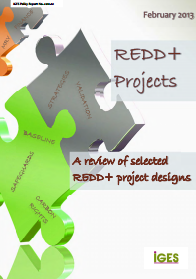A review of selected REDD+ project designs
Summary
Parties to the UNFCCC have agreed that the future global mechanism to mitigate climate change will include incentives for developing countries to protect and enhance carbon stocksin their forest – a concept known as REDD+. At the 13th COP in Bali, parties agreed on Decision2/CP.13 Reducing Emissions from Deforestation in Developing Countries: Approaches to Stimulate Action. This decision encourages support to developing countries to increase their capacity to estimate and reduce forest emissions, and encourages parties to explore a range of actions, identify options and undertake efforts, including demonstration activities, to address the drivers of deforestation. The call for demonstration activities at the 13th COP spurred the development of numerous REDD+ projects that are now found in parts of Africa, Central and South America and Asia.
REDD+ projects could generate information important to the development of national REDD+ strategies and architecture and for the climate change negotiations. There is thus a need to extract and present the information and lessons that are being generated in a systematic and accessible manner. REDD+ Projects: A review of selected REDD+ project designs aims to contribute to meeting this need. Twenty‐seven REDD+ project designs are reviewed, using a common template that covers the basic issues that all REDD+ projects must address to deliver carbon credits.
This review is divided into two parts. Part 1 consists of two chapters. Chapter 1 introduces the topic and the template. Chapter 2 provides a discussion on various elements of the 27 project designs. Part 2 is the annex, which consists ofthe summaries of the 27 project designs.This work is generally based upon outputs produced through a REDD+‐related project funded by the Ministry of Environment, Japan.


 Twitter
Twitter Google+
Google+ Facebook
Facebook LinkedIn
LinkedIn Digg
Digg del.icio.us
del.icio.us StumbleUpon
StumbleUpon